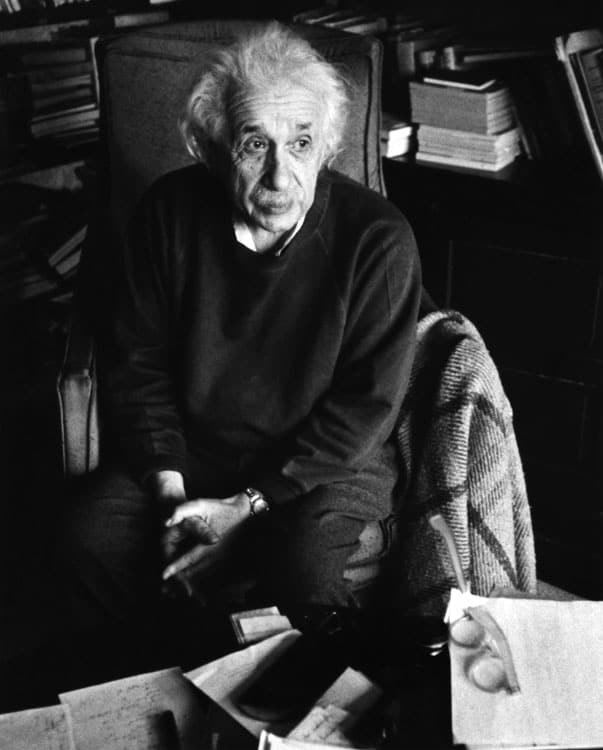Einstein Wrote Back: My Life in Physics
John Moffat
2010 Thomas Allen C$32.95hb 240pp

In his declining years, Albert Einstein cut a saintly figure, moved to anger only when clamorous journalists, photographers and quote-hunters tried to disrupt his working routine. When they knocked on the door of his home in Princeton, he almost always refused to meet them, though his colleague Nandor Balazs once told me that the world’s most famous scientist could not resist talking with a young journalist who had travelled 10 000 miles from India to ask him a few questions about religion. As he got up from the kitchen table and prepared to meet her, he sighed to Balazs, “Oh well, I suppose I’d better go and play God again.”
Einstein was, however, a soft touch as a correspondent, and we now know that he spent many hours patiently replying to letters from people who tried their luck at getting him to put pen to paper. In 1953, two years before his death, one of his correspondents was John Moffat, then a 21-year-old physicist at the Niels Bohr Institute in Copenhagen. Moffat was working on unified field theory and his colleagues were giving him more derision than encouragement, so he wrote to Einstein for advice.
Moffat was surprised three weeks later when Einstein replied sympathetically, noting that “…every individual and every study circle has to retain its own way of thinking, if he does not want to get lost in the maze of possibilities”. This was to be the first of several courteous and helpful letters the Sage of Princeton wrote to Moffat, and now, some five decades later, the latter has understandably made it the centrepiece of his memoir Einstein Wrote Back.
Elsewhere in the book, Moffat – now an affiliate member of the Perimeter Institute in Canada – introduces us to the gallery of theoretical physicists he has met during his long career working in relativity and particle physics. These include Abdus Salam, Murray Gell-Mann, Robert Oppenheimer, Kurt Symanzik, Steven Weinberg and even an infant Edward Witten, whose father, Louis Witten, was leading the Research Institute for Advanced Study in Baltimore.
While exercising the memoirist’s prerogative of name-dropping on almost every page, Moffat simultaneously gives the impression of being an outsider. Although he has made the acquaintance of many stellar physicists, he has apparently never worked closely with them or got to know any of them intimately. He also has his share of prejudices. At one point he comments – I suspect, revealingly – on the modern, “draconian” system of peer review, without actually saying that he has often been on the wrong end of it. He wonders how the young Einstein “could ever have succeeded in publishing many of his iconoclastic papers” under such a system. The truth is that those papers had to pass muster with chief editor Max Planck, a theorist of generous spirit but conservative inclination.
Among the character portraits painted by Moffat, that of the brilliant if egoistic cosmologist Fred Hoyle is especially amusing. When Moffat visited him at St John’s College, Cambridge, he found Hoyle sitting at his desk, with a large oil painting of himself on the wall behind. Reflecting on the juxtaposition, Moffat wonders whether all of Hoyle’s students had to sit through his tutorials and “contemplate Hoyle’s blunt Yorkshire features in duplicate”. Later, Moffat had a similar experience in Hoyle’s cottage, where the great cosmologist intellectually disembowelled a divinity student over tea and cakes. The poor student was sitting beneath another oil painting of Hoyle hung over the fireplace.
Moffat’s stories are always entertaining, though some of them seem to have been a tad embellished in repeated re-tellings. For example, Moffat repeats an anecdote from Nathan Rosen, who recalled that when Einstein received a rejection letter from Physical Review, he “leapt out of his chair and threw the envelope with the letter and the manuscript into his trash can, which he kicked loudly around his office”. This story does lend support to Moffat’s view that Einstein’s work on unified theory led him to be “ostracized by his physicist peers”, but I suspect Rosen was exaggerating somewhat. Like all the other anecdotes in the book, this one is not referenced.
The picture Moffat paints of Paul Dirac mostly rings true, though, especially when he describes an excruciating scene in which Dirac sat at home in complete silence while Moffat waited in vain for conversation to begin. It is entirely believable, too, that Dirac’s wife told her husband that he was “so stupid” that he couldn’t “even put on [his] own trousers”. However, I find it hard to picture Dirac uttering the chirpy greeting to Pauli quoted here: “I have been reading your recent work on quantum field theory, Wolfgang.” Nor do I find it easy to imagine him spending afternoons in the garage “repairing his old Rolls-Royce”. Dirac had no taste for car maintenance or any other mechanical chore and never, according to his family, owned such a fancy car.
Pauli, a brilliant if charmless critic of everyone’s new ideas, including his own, makes several appearances here, always as a charismatic figure, though devoid of grace. At one point, Moffat gives us a vivid, detailed account of the Austrian theorist’s visit to Abdus Salam’s new group at Imperial College, London. This was apparently a red-letter day for the dapper Salam, who put on “what appeared to be a new, dark, three-piece suit, white shirt and St John’s College tie, with his black hair and moustache gleaming”. Moffat tells us that the visit took place in 1959, so it appears that Salam and his students were welcoming a ghost – Pauli having died the previous year.
In Einstein Wrote Back, Moffat has given physicists a wealth of new stories about several of its greatest characters. It is a pleasant read, but it would have been even better if he had submitted himself to the discipline of a tougher editor.



